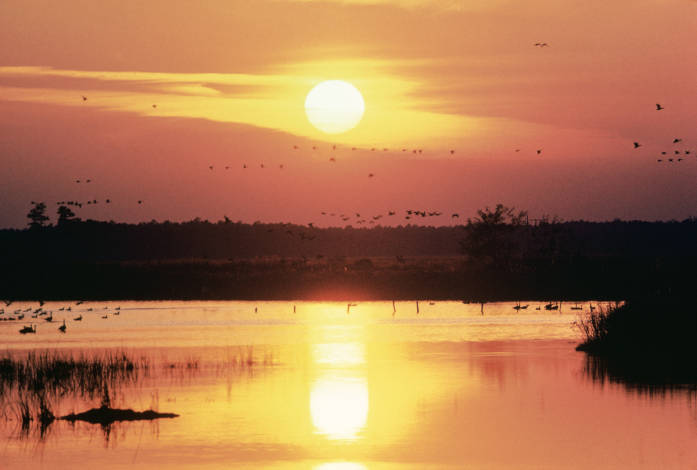
Birds in flight as the sun goes down at the Blackwater National Wildlife Refuge. Photo courtesy of the U.S. Fish and Wildlife Service, licensed Creative Commons Attribution.
The Blackwater National Wildlife Refuge (2145 Key Wallace Dr., 410/228-2677, daily dawn-dusk, vehicles $3, pedestrians $1, cyclists $1) was established in 1933 as a sanctuary for waterfowl migrating along the Atlantic Flyway (a migration route along the Atlantic coast). It is open all year 12 miles south of Cambridge. The refuge encompasses 27,000 acres including freshwater, brackish tidal wetlands, meadows, and forest.
More than 250 species of birds live in the refuge, and it is home to the largest breeding population of bald eagles on the East Coast north of Florida. The eagle population swells in the winter months, when many birds migrate here from northern areas. During the winter, the refuge is also home to more than 35,000 geese and 15,000 ducks. Fall (Sept.-Nov.) is the best time to see migrating waterfowl and songbirds.
A wide variety of mammals also live in the refuge. Delmarva fox squirrels, southern flying squirrels, voles, shrews, nutria, gray foxes, red foxes, river otters, mink, skunks, deer, and beavers all call the refuge home.
There is a wonderful visitor center on Key Wallace Drive (year-round Mon.-Fri. 8am- 4pm, Sat.-Sun. 9am-5pm) with wildlife exhibits, nature books, birding guides, a butterfly garden, maps, restrooms, and a gift shop. The prime attraction in the refuge is the Wildlife Drive, a four-mile paved road where visitors can drive, bike, and walk through the refuge to view wildlife. There is also a great viewing platform over the marsh. In addition to the Wildlife Drive, the refuge has four land trails and three paddling trails. Visitors can also hunt, fish, and crab. Environmental education programs are also offered for young people.
Excerpted from the First Edition of Moon Virginia & Maryland.